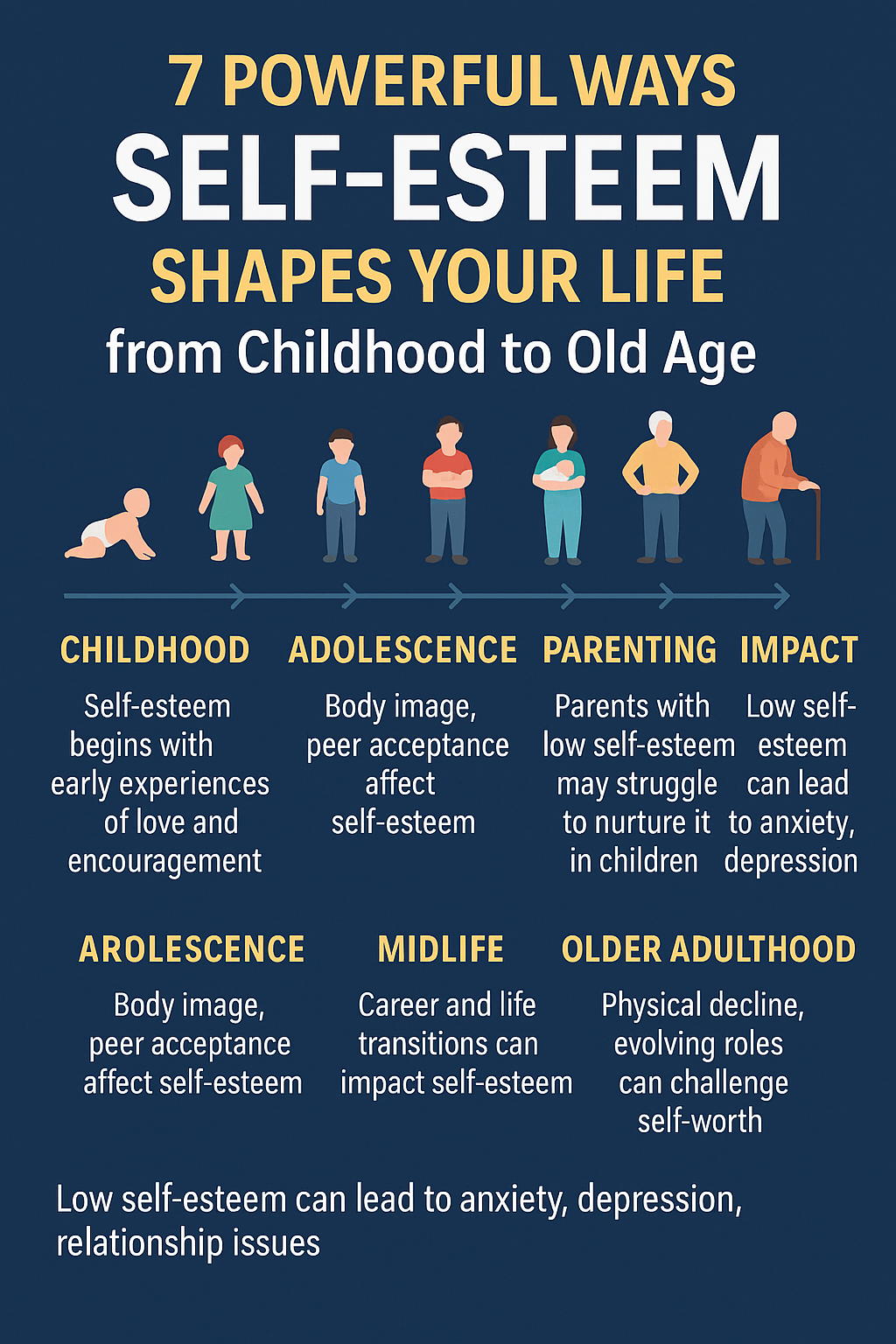
Self-esteem: “7 Powerful Ways Shapes Your Life from Childhood to Old Age”
It is the silent architect of a person’s mental, emotional, and social landscape. It influences how we see ourselves, how we interact with others, and how we make life decisions. Throughout the different stages of life, self-esteem plays a pivotal role in shaping confidence, resilience, and identity.
Let’s explore how self-esteem affects a person’s life from childhood through old age—with real-life examples and psychological insight.
Childhood: The Foundation Begins at Home
In early childhood, it is primarily shaped by interactions with caregivers. When children are loved, encouraged, and accepted, they begin to develop a positive view of themselves. Conversely, harsh criticism, neglect, or lack of attention can lead to feelings of inadequacy.
Example: A child whose efforts are appreciated—even if they make mistakes—tends to develop trust in their abilities. In contrast, a child constantly compared to others may withdraw or develop anxiety, believing they’re not good enough.
Adolescence: It Battles with Identity and Peer Pressure
Adolescence is marked by self-discovery, changing bodies, and the need for social belonging.It takes a hit or gets a boost depending on peer acceptance, body image, academic performance, and family support.
Example: A teenager with high self-esteem may say “no” to peer pressure, assert their boundaries, and pursue hobbies without fear of judgment. On the other hand, someone with low self-esteem might constantly seek validation or fall into risky behaviors to fit in.
Early Adulthood: Career Choices and Relationships
In early adulthood, it is tied to independence, career paths, and romantic relationships. This is a time of making big decisions. People with healthy self-esteem are more likely to choose careers and partners that align with their values rather than societal expectations.
Example: Someone with strong self-esteem might leave a high-paying but unfulfilling job to pursue their passion, knowing they’re capable. In contrast, low self-esteem might keep a person stuck in toxic relationships or jobs due to fear of change or failure.
Parenting: The Cycle Continues
People often replicate what they learned in childhood. A parent with low self-esteem may unknowingly pass on emotional insecurity to their children. They might overcompensate with control or under-parent due to their own unresolved issues.
Example: A confident parent is more likely to model emotional resilience and open communication. Someone with poor self-esteem might struggle with consistent discipline or overreact to small issues.
Midlife: Challenges and Reevaluation
Midlife can bring a crisis of confidence as people reevaluate goals, face aging, or deal with regrets. For those with low self-esteem, this period may trigger anxiety or a sense of failure. However, individuals with balanced self-esteem tend to see midlife as a time for growth and transformation.
Example: A person in their 40s with a strong sense of self-worth may start a new career, go back to school, or focus on mental health. In contrast, someone with fragile self-esteem may feel stuck or depressed.
Older Adulthood: Legacy
In old age, it influences how people perceive their worth without roles like career or parenting defining them. Physical decline, loss of loved ones, or reduced independence can test self-worth.
Example: An elderly individual with high self-esteem may still engage with community, mentor younger people, or celebrate their life’s journey. Someone with low self-esteem might feel forgotten, useless, or bitter.
The Lifelong Impact
How someone feels about themselves—it can lead to:
- Anxiety and depression
- Difficulty forming or maintaining relationships
- Poor coping mechanisms like addiction or withdrawal
- Career dissatisfaction
- Physical health issues from chronic stress
On the flip side, balanced self-esteem enhances:
- Confidence and motivation
- Healthier relationships
- Better stress management
- Emotional resilience
Final Thoughts
Self-esteem isn’t static. It evolves based on experiences, self-awareness, and healing. The good news? It’s never too late to build or rebuild it. Therapy, mindfulness, supportive relationships, and setting small achievable goals can all help foster a stronger sense of self-worth.
Whether you’re a parent shaping a child’s mind, a young adult finding your way, or someone in later life reflecting on your journey, remember: It is the key to living a life that feels whole.

